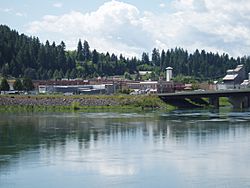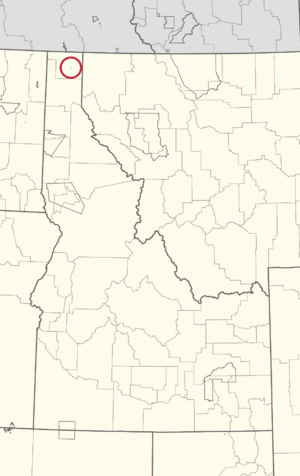Kootenai Tribe of Idaho facts for kids
| ʔaq̓anqmi | |
|---|---|

Bonners Ferry on the Kootenai River
|
|
| Total population | |
| 165 | |
| Regions with significant populations | |
| Languages | |
| Kutenai, English | |
| Religion | |
| traditional tribal religion, Sun Dance religion | |
| Related ethnic groups | |
| other Kootenai people, Flatheads, Kalispel people |
The Kootenai Tribe of Idaho (in their own language, ʔaq̓anqmi) is a group of Kootenai people. They are officially recognized by the United States government. Sometimes, they are called the Idaho Ksanka.
The Kootenai people are also known as the Ktunaxa (pronounced tun-AH-hah). They are an Indigenous group who have lived in the Northwest Plateau region for a very long time. The name "Kootenay" is often used in Canada, while "Kootenai" is common in the United States.
The Kootenai Tribe is one of five federally recognized tribes in Idaho. The other tribes are the Coeur d'Alene, Nez Perce, Shoshone-Bannock, and Western Shoshone-Northern Paiute.
Contents
The Kootenai Reservation
The Kootenai Reservation was first created in 1896. Over time, some of their land was lost. The reservation was officially re-established in 1974.
Today, the reservation covers about 2,695 acres (or 4.2 square miles). It is located in Boundary County, Idaho, right along U.S. Route 95.
How the Tribe is Governed
The main office for the Kootenai Tribe is in Bonners Ferry, Idaho. The tribe is led by a tribal council. This council has nine members who are chosen by the people through elections.
The current chairman of the tribal council is Gary FX Aitken Jr. The council works to make decisions for the tribe and its members.
Kootenai Language
Traditionally, the Kootenai people speak the Kutenai language. This language is unique because it is a language isolate. This means it is not closely related to any other known language family.
The Kutenai language has its own dictionary and grammar. It is written using the Latin alphabet, which is the same alphabet used for English.
History of the Kootenai People
The Kootenai people traditionally lived along the Kootenai River. This area includes parts of Idaho, Montana, and British Columbia in Canada. They were hunter-gatherers, meaning they found their food by hunting animals and gathering plants. Salmon was a very important part of their diet.
During the winter, they lived in permanent villages. Their homes were cone-shaped and made from wooden poles covered with rush mats.
In 1855, the Kootenai Tribe chose not to sign a treaty with the U.S. government. This treaty would have made them give up their traditional lands in Idaho. It also would have forced them to join with other smaller tribes in Montana.
Later, the Dawes Act tried to divide tribal lands into smaller pieces for individual people. Because of unfair land loss, the tribe was given $425,000 in a land claims settlement in 1960. This money was to make up for some of the land they had lost.
On September 20, 1974, the 67 members of the Kootenai Tribe did something very unusual. They formally declared "war" on the United States. This was not a violent act. Instead, it was a peaceful way to get the government's attention and gain official recognition for their tribe. They wanted their own reservation and fair payment for their ancestral lands.
By drawing attention to their situation, the tribe was given 12.5 acres of federal land. This land was around the old mission in Bonners Ferry, Idaho. This was made official when President Gerald Ford signed a bill in October 1974.
Economic Development
Since 1986, the Kootenai Tribe has worked to create businesses that help their community. They own and operate the Kootenai River Inn in Bonners Ferry. This business has grown to include the Kootenai River Inn Casino and Spa. It also has the Springs Restaurant, a Casino Deli, the Kootenai Day Spa, and a gift shop.
Other businesses on the reservation include timber (wood production), tourism, and selling sand and gravel. The tribe also runs a sturgeon hatchery, which helps to raise and protect sturgeon fish.


